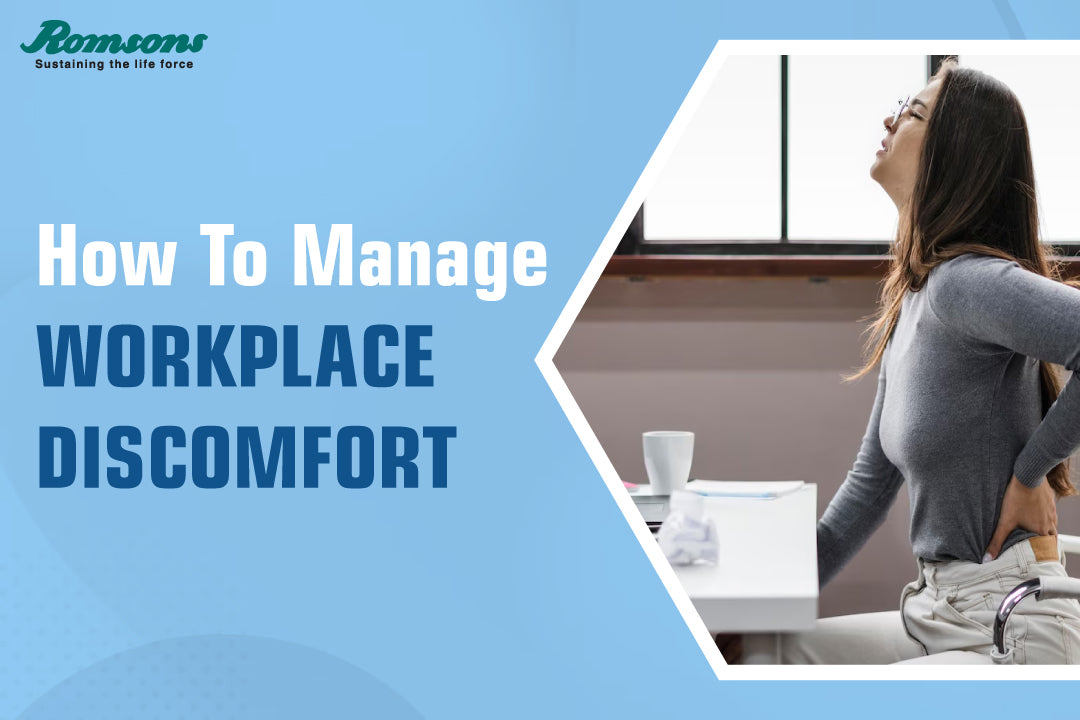How To Manage Workplace Discomfort ?

In the modern workplace culture, the glorification of long hours and constant busyness can overshadow a crucial truth: productivity thrives on a foundation of well-being. Yet, many people struggle with workplace discomfort, a silent thief that saps energy, focus, and ultimately results in backaches, eyestrain, and tension headaches—these are just a few battle cries of a body yearning for a more ergonomic existence. By incorporating some simple strategies, you can transform your workspace from a discomfort zone to a haven of pain-free productivity.
Easy Ways to Manage Workplace Discomfort
There are strategies we can employ to manage workplace discomfort effectively, ensuring that we stay productive and healthy. Let's explore some of these strategies:
1. Ergonomic Workstations:
The foundation of pain-free productivity lies in ergonomics. An ergonomic workstation is designed to support the body's natural posture and movements, reducing strain and discomfort. Invest in an ergonomic chair that provides proper lumbar support and allows for adjustments in height and tilt. Similarly, ensure that your desk setup promotes good posture, with the monitor positioned at eye level and the keyboard and mouse within easy reach. Small adjustments to your workstation can make a world of difference in preventing discomfort.
2. Regular Breaks and Movement:
Sitting for prolonged periods can lead to stiffness and muscle tension. Combat this by incorporating regular breaks and movement into your workday. Take a simple step and set a timer to remind yourself to stand up, stretch, and walk about once every hour. Simple stretching exercises like neck rolls, shoulder shrugs, and wrist flexion and extension can help alleviate tension and improve circulation. Consider adding standing or adjustable desks to your workstation so that you may alternate between sitting and standing throughout the day.
3. Mindful Posture Awareness:
Awareness of posture is crucial to prevent workplace discomfort. Pay attention to how you're sitting or standing throughout the day, and make adjustments as needed. Keep your shoulders relaxed, your spine aligned, and your feet flat on the floor when sitting. Avoid slouching or leaning forward, which can put tension on your back and neck muscles. By practicing mindful posture awareness, you can reduce the risk of developing chronic pain and discomfort over time.
4. Eye Care:
In today's digital age, many of us spend hours staring at screens, which can contribute to eye strain and discomfort. To ease this, use the 15-15-15 rule: after 15 minutes, take a 15-second break and look 15 feet away. This helps reduce eye fatigue and prevents overexertion of the eye muscles. Additionally, consider adjusting the brightness and contrast of your screen to reduce glare and eye strain. If you wear glasses, make sure your prescription is up-to-date to optimise visual comfort.
5. Proper Keyboard and Mouse Usage:
Repetitive tasks such as typing and clicking can put strain on the wrists and hands, leading to discomfort. To minimise this discomfort, ensure that your keyboard and mouse are positioned correctly to promote neutral wrist alignment. Use keyboard shortcuts and ergonomic accessories, such as wrist rests, to reduce strain on the wrists and forearms. Consider alternating between different input devices, such as a mouse and a trackpad, to vary hand movements and prevent repetitive stress injuries.
6. Stress Management Techniques:
Workplace discomfort is not just physical—it can also be exacerbated by stress and tension. Incorporate stress management techniques such as deep breathing, meditation, or mindfulness exercises into your daily routine to promote relaxation and alleviate mental strain. Take regular breaks to step away from work-related stressors and engage in activities that promote calmness and well-being, whether it's going for a walk, listening to music, or practicing yoga.
7. Healthy Lifestyle Habits:
Maintaining overall health and well-being is essential to managing workplace discomfort. Make sure to prioritise adequate sleep, nutrition, and hydration to support your body's natural healing processes. Regular exercise can also help improve posture, flexibility, and overall resilience to discomfort. In addition, consider seeking professional help from a physical therapist or occupational therapist if you're experiencing persistent or severe discomfort that interferes with your ability to work comfortably.
8. Communication:
If you're experiencing discomfort due to aspects of your work environment or tasks, don't be afraid to speak up. Talk to your manager or HR department about possible solutions, whether it's adjusting your workstation, redistributing tasks, or implementing ergonomic training for employees. Open communication can help create a more supportive and accommodating work environment for everyone.
9. Self-Care:
Finally, prioritise self-care both inside and outside of the workplace. Set boundaries around your work hours and responsibilities to prevent burnout. Make time for activities that bring you joy and relaxation, whether it's spending time with loved ones, pursuing hobbies, or simply enjoying some quiet time alone.
Managing workplace discomfort is the key to maintaining productivity and well-being in today's hustle-filled work environments. By implementing ergonomic principles, taking regular breaks, practicing mindful posture awareness, and incorporating stress management techniques, you can effectively alleviate discomfort and promote pain-free productivity. Remember to prioritise your health and listen to your body's signals, making adjustments as needed to create a workspace that supports both your physical and mental well-being. With these strategies in place, you can work smarter, and achieve your goals with ease and comfort.

